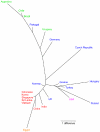Population structure of a hybrid clonal group of methicillin-resistant Staphylococcus aureus, ST239-MRSA-III
- PMID: 20062529
- PMCID: PMC2797301
- DOI: 10.1371/journal.pone.0008582
Population structure of a hybrid clonal group of methicillin-resistant Staphylococcus aureus, ST239-MRSA-III
Abstract
The methicillin-resistant Staphylococcus aureus (MRSA) clonal group known as ST239-MRSA-III is notable for its hybrid origin and for causing sustained hospital epidemics worldwide since the late 1970s. We studied the population structure of this MRSA clonal group using a sample of 111 isolates that were collected over 34 years from 29 countries. Genetic variation was assessed using typing methods and novel ascertainment methods, resulting in approximately 15 kb of sequence from 32 loci for all isolates. A single most parsimonious tree, free of homoplasy, partitioned 28 haplotypes into geographically-associated clades, including prominent European, Asian, and South American clades. The rate of evolution was estimated to be approximately 100x faster than standard estimates for bacteria, and dated the most recent common ancestor of these isolates to the mid-20th century. Associations were discovered between the ST239 phylogeny and the ccrB and dru loci of the methicillin resistance genetic element, SCCmec type III, but not with the accessory components of the element that are targeted by multiplex PCR subtyping tools. In summary, the evolutionary history of ST239 can be characterized by rapid clonal diversification that has left strong evidence of geographic and temporal population structure. SCCmec type III has remained linked to the ST239 chromosome during clonal diversification, but it has undergone homoplasious losses of accessory components. These results provide a population genetics framework for the precise identification of emerging ST239 variants, and invite a re-evaluation of the markers used for subtyping SCCmec.
Conflict of interest statement
Figures



References
-
- Grundmann H, de Sousa MA, Boyce J, Tiemersma E. Emergence and resurgence of meticillin-resistant Staphylococcus aureus as a public-health threat. Lancet. 2006;368:874–885. - PubMed
-
- Oliveira DC, Tomasz A, de Lencastre H. Secrets of success of a human pathogen: molecular evolution of pandemic clones of meticillin-resistant Staphylococcus aureus. Lancet Infect Dis. 2002;2:180–189. - PubMed
Publication types
MeSH terms
Substances
Grants and funding
LinkOut - more resources
Full Text Sources
Medical

